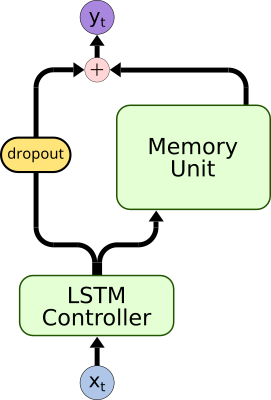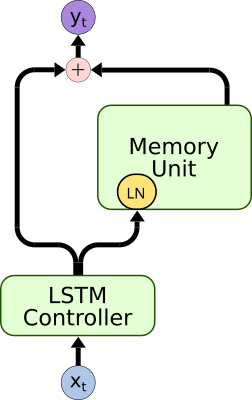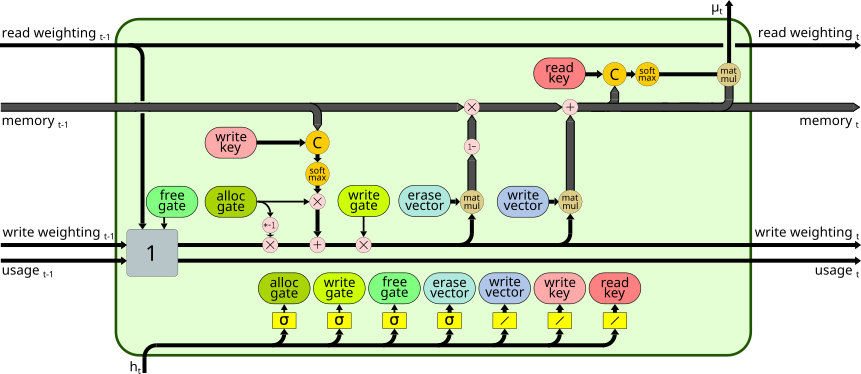| adnc | ||
| experiments/pre_trained | ||
| images | ||
| scripts | ||
| test | ||
| .gitattributes | ||
| .gitignore | ||
| .travis.yml | ||
| LICENSE | ||
| README.md | ||
| requirements-gpu.txt | ||
| requirements.txt | ||
| setup.py | ||
Advanced Differentiable Neural Computer
This repository is under construction and some comments and functions are missing.
This repository contains a implementation of a Differentiable Neural Computer (DNC) with advancements for a more robust and scalable usage in Question Answering. It is applied to:
- 20 bAbI QA tasks with state-of-the-art results
- CNN Reading Comprehension Task with passable results without any adaptation or hyper-parameter tuning.
This repository is the groundwork for the MRQA 2018 paper submission "Robust and Scalable Differentiable Neural Computer for Question Answering". It contains a modular and fully configurable DNC with the following advancements:
The plot below shows the impact of the different advancements in the word error rate with the bAbI task 1.
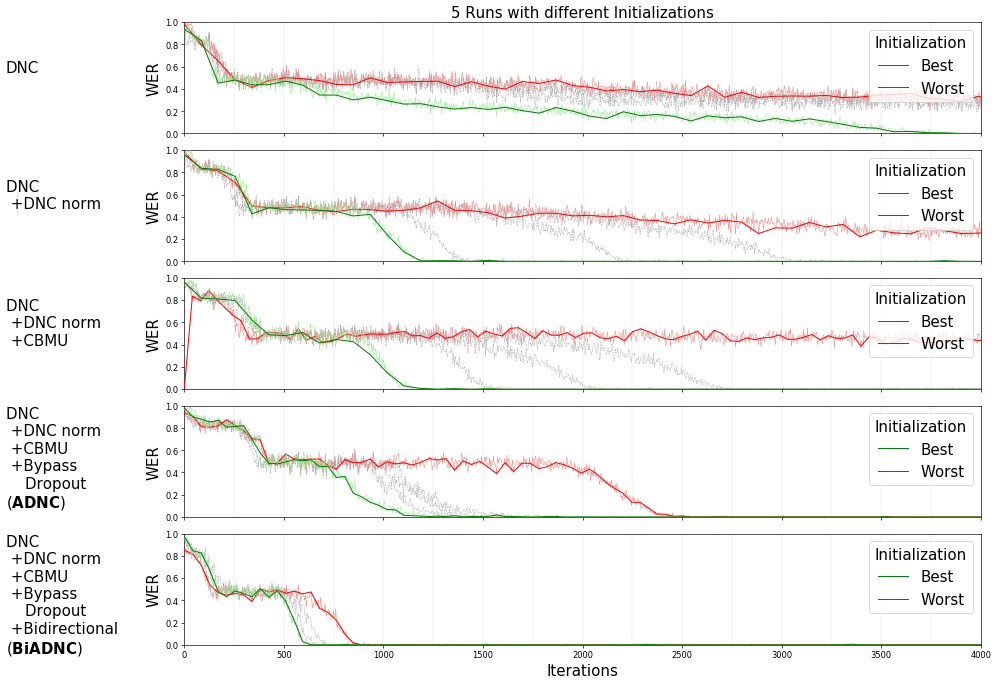 |
|---|
Furthermore, it contains a set of rich analysis tools to get a deeper insight in the functionality of the ADNC. For example that the advancements lead to a more meaningful gate usage of the memory cell as you can see in the following plots:
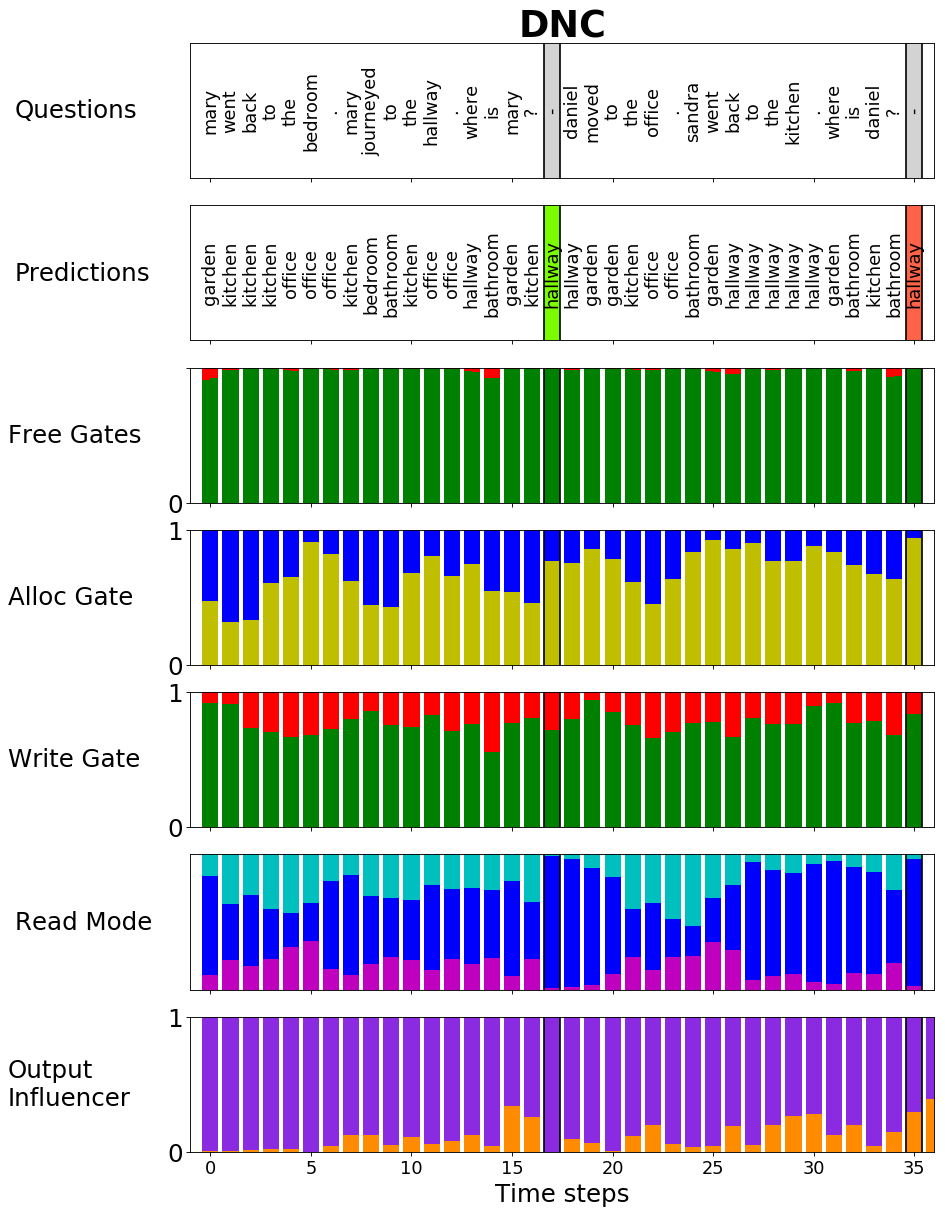 |
 |
|---|
How to use:
Setup ADNC
To setup an virtual environment and install ADNC:
git clone https://github.com/joergfranke/ADNC.git
cd ADNC/
python3 -m venv venv
source venv/bin/activate
pip install -e .
Inference
The repository contains different pre-trained models in the experiments folder.
For bAbI inference, choose pre-trained model e.g. adnc and run:
python scripts/inference_babi_task.py adnc
Possible models are dnc, adnc, biadnc on bAbi Task 1 and biadnc-all, biadnc-aug16-all for all bAbI tasks with or without augmentation of task 16.
For CNN inference of pre-trained ADNC run:
python scripts/inference_babi_task.py
Training
The configuration file scripts/config.yml contains the full config of the ADNC training. The training script can be run with:
python scripts/start/training.py
It starts a bAbI training and plots every epoch a function plot to control the training progress.
Plots
To plot a function plot of the bAbI task choose pre-trained model e.g. adnc and run:
python scripts/plot_function_babi_task.py
Possible models are dnc, adnc, biadnc on bAbi Task 1 and biadnc-all, biadnc-aug16-all for all bAbI tasks with or without augmentation of task 16.
bAbI Results
| Task | DNC | EntNet | SDNC | ADNC | BiADNC | BiADNC +aug16 |
|---|---|---|---|---|---|---|
| 1: 1 supporting fact | 9.0 ± 12.6 | 0.0 ± 0.1 | 0.0 ± 0.0 | 0.1 ± 0.0 | 0.1 ± 0.1 | 0.1 ± 0.0 |
| 2: 2 supporting facts | 39.2 ± 20.5 | 15.3 ± 15.7 | 7.1 ± 14.6 | 0.8 ± 0.5 | 0.8 ± 0.2 | 0.5 ± 0.2 |
| 3: 3 supporting facts | 39.6 ± 16.4 | 29.3 ± 26.3 | 9.4 ± 16.7 | 6.5 ± 4.6 | 2.4 ± 0.6 | 1.6 ± 0.8 |
| 4: 2 argument relations | 0.4 ± 0.7 | 0.1 ± 0.1 | 0.1 ± 0.1 | 0.0 ± 0.0 | 0.0 ± 0.0 | 0.0 ± 0.0 |
| 5: 3 argument relations | 1.5 ± 1.0 | 0.4 ± 0.3 | 0.9 ± 0.3 | 1.0 ± 0.4 | 0.7 ± 0.1 | 0.8 ± 0.4 |
| 6: yes/no questions | 6.9 ± 7.5 | 0.6 ± 0.8 | 0.1 ± 0.2 | 0.0 ± 0.1 | 0.0 ± 0.0 | 0.0 ± 0.0 |
| 7: counting | 9.8 ± 7.0 | 1.8 ± 1.1 | 1.6 ± 0.9 | 1.0 ± 0.7 | 1.0 ± 0.5 | 1.0 ± 0.7 |
| 8: lists/sets | 5.5 ± 5.9 | 1.5 ± 1.2 | 0.5 ± 0.4 | 0.2 ± 0.2 | 0.5 ± 0.3 | 0.6 ± 0.3 |
| 9: simple negation | 7.7 ± 8.3 | 0.0 ± 0.1 | 0.0 ± 0.1 | 0.0 ± 0.0 | 0.1 ± 0.2 | 0.0 ± 0.0 |
| 10: indefinite knowledge | 9.6 ± 11.4 | 0.1 ± 0.2 | 0.3 ± 0.2 | 0.1 ± 0.2 | 0.0 ± 0.0 | 0.0 ± 0.1 |
| 11: basic coreference | 3.3 ± 5.7 | 0.2 ± 0.2 | 0.0 ± 0.0 | 0.0 ± 0.0 | 0.0 ± 0.0 | 0.0 ± 0.0 |
| 12: conjunction | 5 ± 6.3 | 0.0 ± 0.0 | 0.2 ± 0.3 | 0.0 ± 0.0 | 0.0 ± 0.1 | 0.0 ± 0.0 |
| 13: compound coreference | 3.1 ± 3.6 | 0.0 ± 0.1 | 0.1 ± 0.1 | 0.0 ± 0.0 | 0.0 ± 0.0 | 0.0 ± 0.0 |
| 14: time reasoning | 11 ± 7.5 | 7.3 ± 4.5 | 5.6 ± 2.9 | 0.2 ± 0.1 | 0.8 ± 0.7 | 0.3 ± 0.1 |
| 15: basic deduction | 27.2 ± 20.1 | 3.6 ± 8.1 | 3.6 ± 10.3 | 0.1 ± 0.1 | 0.1 ± 0.1 | 0.1 ± 0.1 |
| 16: basic induction | 53.6 ± 1.9 | 53.3 ± 1.2 | 53.0 ± 1.3 | 52.1 ± 0.9 | 52.6 ± 1.6 | 0.0 ± 0.0 |
| 17: positional reasoning | 32.4 ± 8 | 8.8 ± 3.8 | 12.4 ± 5.9 | 18.5 ± 8.8 | 4.8 ± 4.8 | 1.5 ± 1.8 |
| 18: size reasoning | 4.2 ± 1.8 | 1.3 ± 0.9 | 1.6 ± 1.1 | 1.1 ± 0.5 | 0.4 ± 0.4 | 0.9 ± 0.5 |
| 19: path finding | 64.6 ± 37.4 | 70.4 ± 6.1 | 30.8 ± 24.2 | 43.3 ± 36.7 | 0.0 ± 0.0 | 0.1 ± 0.1 |
| 20: agent’s motivation | 0.0 ± 0.1 | 0.0 ± 0.0 | 0.0 ± 0.0 | 0.1 ± 0.1 | 0.1 ± 0.1 | 0.1 ± 0.1 |
| Mean WER: | 16.7 ± 7.6 | 9.7 ± 2.6 | 6.4 ± 2.5 | 6.3 ± 2.7 | 3.2 ± 0.5 | 0.4 ± 0.3 |
| Failed Tasks (<5%): | 11.2 ± 5.4 | 5.0 ± 1.2 | 4.1 ± 1.6 | 3.2 ± 0.8 | 1.4 ± 0.5 | 0.0 ± 0.0 |
CNN Results
| Model | valid | test |
|---|---|---|
| Deep LSTM Reader | 55.0 | 57.0 |
| Attentive Reader | 61.6 | 63.0 |
| ADNC | 67.5 | 69.0 |
| AS Reader | 68.6 | 69.5 |
| Stanford AR | 72.2 | 72.4 |
| AoA Reader | 73.1 | 74.4 |
| ReasoNet | 72.9 | 74.7 |
| GA Reader | 77.9 | 77.9 |


